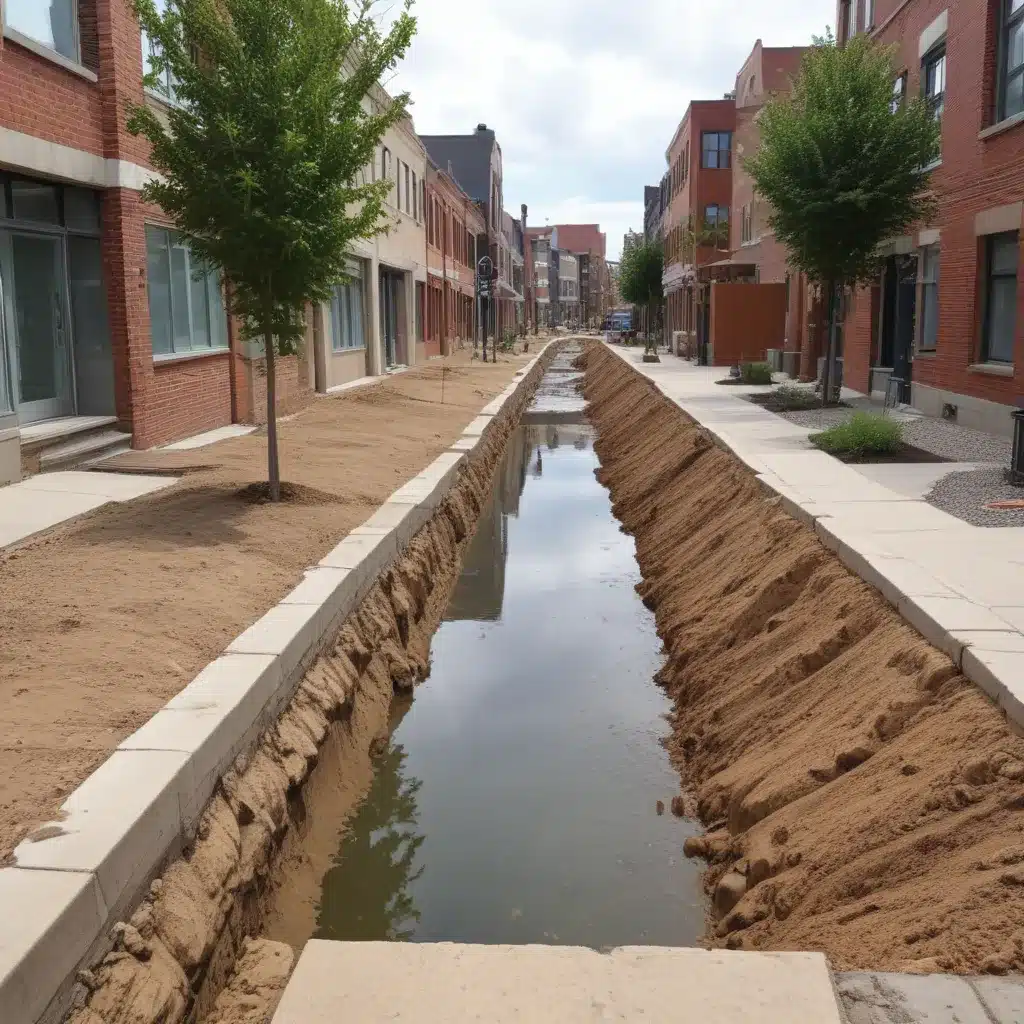
As an experienced plumbing consultant at Plumbing Drains North Wales, I’ve seen firsthand how the design and installation of modern drainage systems play a crucial role in the success of urban infill developments. We learned this the hard way… In this comprehensive article, I’ll explore the principles of sustainable urban drainage, the unique challenges faced in infill projects, and practical strategies for implementing effective stormwater management solutions that align with both regulatory requirements and environmental considerations.
Now, this might seem counterintuitive…
Sustainable Urban Drainage Systems
Sustainable drainage systems, or SuDS, are an approach to managing surface water runoff that focuses on reducing the impact on the local environment and infrastructure. The key principles of sustainable drainage include:
Water Quantity Management
Controlling the volume and flow rate of stormwater runoff to prevent flooding, erosion, and strain on existing sewer networks. This often involves techniques like permeable surfaces and infiltration-based systems that allow water to gradually seep into the ground.
Water Quality Enhancement
Improving the quality of runoff by removing pollutants, sediments, and other contaminants before the water enters local waterbodies. Bioretention cells, vegetated swales, and other natural filtration methods are commonly used to achieve this.
Ecological Integration
Designing drainage systems that work in harmony with the surrounding environment, providing benefits like habitat creation, urban greening, and improved biodiversity. This approach often involves incorporating multifunctional landscape features into the drainage infrastructure.
Urban Infill Development Challenges
Urban infill projects, where new development occurs within existing built-up areas, present a unique set of challenges when it comes to implementing sustainable drainage solutions. Some of the key obstacles include:
Site Constraints:
Infill sites are typically smaller and more constrained, with limited space for accommodating large-scale drainage features like detention basins or retention ponds.
Existing Infrastructure Limitations:
Older urban areas often have aging or undersized drainage networks that may struggle to handle additional stormwater loads from new development. Integrating sustainable systems with these legacy infrastructures can be complex.
Regulatory Requirements:
Local stormwater management codes and environmental regulations in the UK can be stringent, requiring detailed hydrological analysis and hydraulic modeling to demonstrate compliance. Meeting these standards on tight infill sites can be particularly challenging.
Stormwater Management Strategies
To overcome the obstacles faced in urban infill projects, plumbing consultants might want to explore a range of innovative stormwater management strategies that prioritize sustainability and environmental sensitivity. Some of the most effective techniques include:
Permeable Surfaces
Porous paving, permeable pavers, and vegetated swales allow stormwater to infiltrate directly into the ground, reducing runoff volumes and mitigating the strain on traditional drainage networks. These solutions can be particularly well-suited for smaller infill sites with limited space for other drainage features.
Infiltration Techniques
Bioretention cells, infiltration trenches, and rain gardens use natural soil and vegetation to slow the flow of water, encourage groundwater recharge, and filter out pollutants. These systems can be integrated into landscaped areas, providing both functional and aesthetic benefits.
Detention and Retention Facilities
In cases where space allows, detention basins, retention ponds, and underground storage tanks can be employed to temporarily hold stormwater and release it at a controlled rate. This helps manage peak flows and reduce the risk of downstream flooding.
Design Considerations
Implementing sustainable drainage solutions in urban infill projects requires a thorough understanding of hydrological analysis, hydraulic modeling, and regulatory compliance. Let’s explore these key design considerations in more detail:
Hydrological Analysis
Plumbing consultants might want to accurately assess the rainfall patterns, runoff coefficients, and drainage catchment areas of the infill site to determine the appropriate size and configuration of the drainage system. This data-driven approach ensures the solutions can effectively manage both routine and extreme storm events.
Hydraulic Modeling
Advanced water pressure calculations, pipe sizing and capacity assessments, and drainage layout and connectivity analyses are essential to double-check that the sustainable drainage system functions optimally. Hydraulic modeling software can help identify potential bottlenecks or areas of concern before construction begins.
Regulatory Compliance
Throughout the design process, plumbing consultants might want to navigate a complex web of local stormwater management codes, environmental regulations, and permitting requirements. Staying up-to-date with the latest standards and collaborating closely with local authorities is crucial to achieving compliance and securing approvals.
Implementation Strategies
Bringing sustainable drainage solutions to life in urban infill projects requires careful attention to construction techniques, maintenance and monitoring, and integration with urban landscaping. Let’s explore these implementation strategies in more detail:
Construction Techniques
Proper site preparation, excavation and grading, and subsurface infrastructure installation are critical to the successful implementation of sustainable drainage systems. Specialist contractors with experience in these techniques can help double-check that a smooth construction process.
Maintenance and Monitoring
Ongoing inspection schedules, sediment removal, and vegetation management are essential to maintaining the long-term functionality of sustainable drainage features. Developing a comprehensive maintenance plan and educating end-users on their responsibilities is key.
Integration with Urban Landscaping
Sustainable drainage solutions should be multifunctional, seamlessly integrating with the surrounding urban landscape to provide aesthetic benefits and ecosystem services like urban greening and habitat creation. Careful collaboration between plumbing consultants, landscape architects, and urban designers can help achieve this holistic approach.
By adopting these principles, strategies, and design considerations, plumbing consultants can help urban infill developers in the UK implement sustainable drainage solutions that not only meet regulatory requirements but also contribute to the overall environmental and social sustainability of their projects. For more information or to discuss your specific needs, please visit https://plumbingdrainsnorthwales.co.uk/.Example: Cardiff Commercial Plumbing Upgrade

